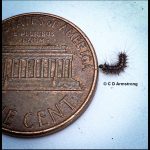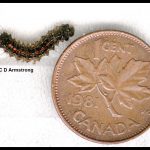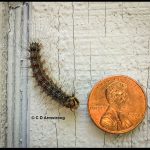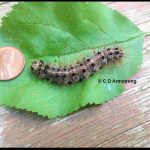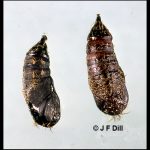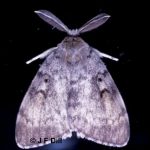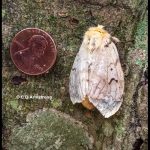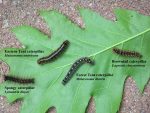Spongy Moth (new name for an old pest)
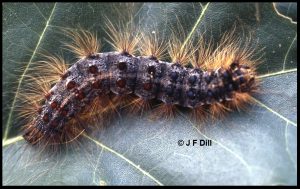 Spongy Moth (Lymantria dispar), introduced accidentally in 1868/1869 into Massachusetts from Europe, is a major pest of hardwood trees in the eastern U.S. and in bordering areas of eastern Canada. Spongy moth caterpillars feed on most hardwood trees, except ash. They prefer oak, poplar, gray birch and fruit trees. When half grown or larger, the larvae are also likely to feed on evergreens, including Colorado blue spruce, Picea pungens. As the number of spongy moth larvae in an area increases, their favorite food sources become depleted. The larvae are then likely to feed on other ornamental trees and shrubs.
Spongy Moth (Lymantria dispar), introduced accidentally in 1868/1869 into Massachusetts from Europe, is a major pest of hardwood trees in the eastern U.S. and in bordering areas of eastern Canada. Spongy moth caterpillars feed on most hardwood trees, except ash. They prefer oak, poplar, gray birch and fruit trees. When half grown or larger, the larvae are also likely to feed on evergreens, including Colorado blue spruce, Picea pungens. As the number of spongy moth larvae in an area increases, their favorite food sources become depleted. The larvae are then likely to feed on other ornamental trees and shrubs.
Late-stage caterpillars are hairy, dark and easily distinguished by five pairs of blue spots on the front body segments and six pairs of red spots on the back body segments. Fully grown larvae are 1-1/2 to 2-1/2 inches long. About 70 percent of their food is consumed during this stage of development; they are able to strip a tree overnight. Female spongy moths cannot fly. Consequently, after mating, they do not move far from their pupation site to lay their 500 or more eggs.
- 2nd instar Spongy moth caterpillar (males go through five instar stages, while females go through six; each stage lasts about two weeks depending on weather)
- 3rd instar Lymantria dispar caterpillar (6/17/2019; Turner, Maine)
- 4th instar Lymantria dispar (Spongy Moth) caterpillar
- Late instar stage Lymantria dispar (Spongy Moth) caterpillar (Etna, ME; 6/20/2021)
- Lymantria dispar (final instar/mature larva)
- Lymantria dispar (Spongy Moth) (mature larva and a pupa)
- A pair of Spongy Moth (Lymantria dispar) pupae
- Spongy Moth (Lymantria dispar) (male)
- Spongy Moth (Lymantria dispar) (female) (Dixmont, ME; 7/12/2021)
- Comparison of four different caterpillar species in Maine that are sometimes difficult for people to differentiate, and oak is one of the hosts they all have in common (Photographed: central Maine; 6/12/2022) (Eastern Tent caterpillar, Spongy caterpillar, Forest Tent caterpillar, and the Browntail caterpillar)
Additional Information:
- Spongy Moth (UMaine Extension’s Published Fact Sheet)
- Spongy Moth [pdf] (Maine Forest Service)

